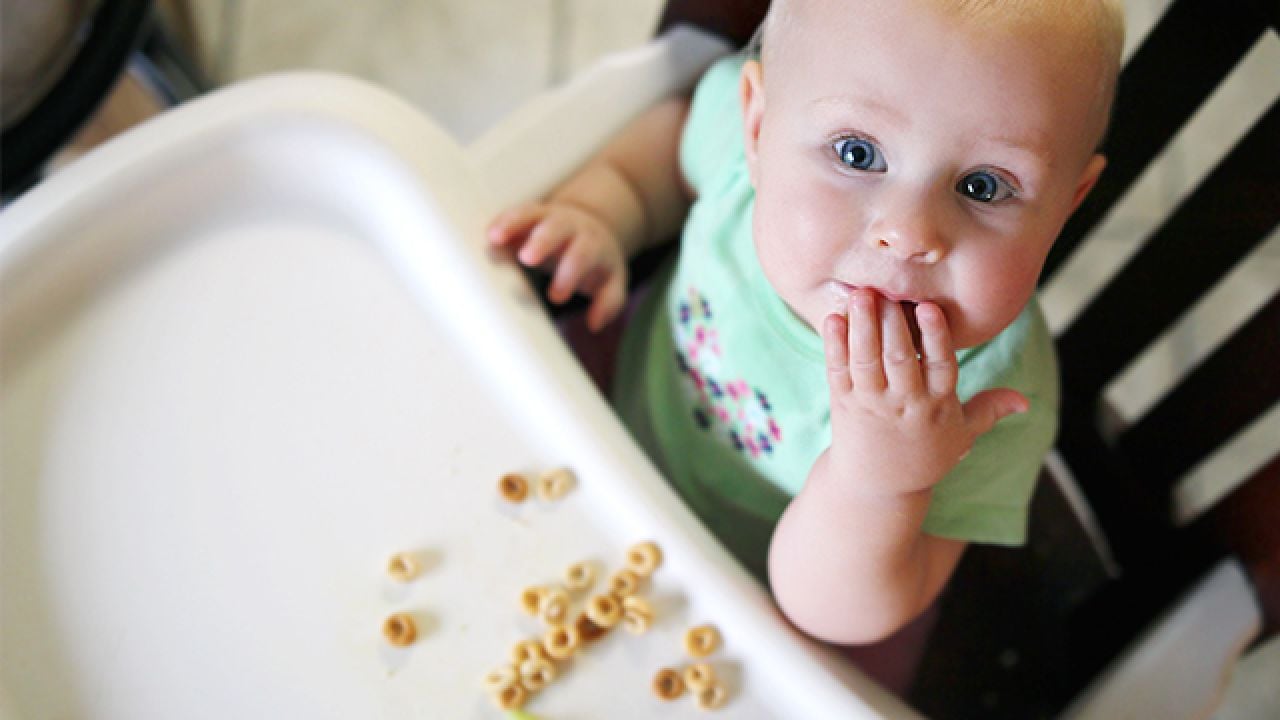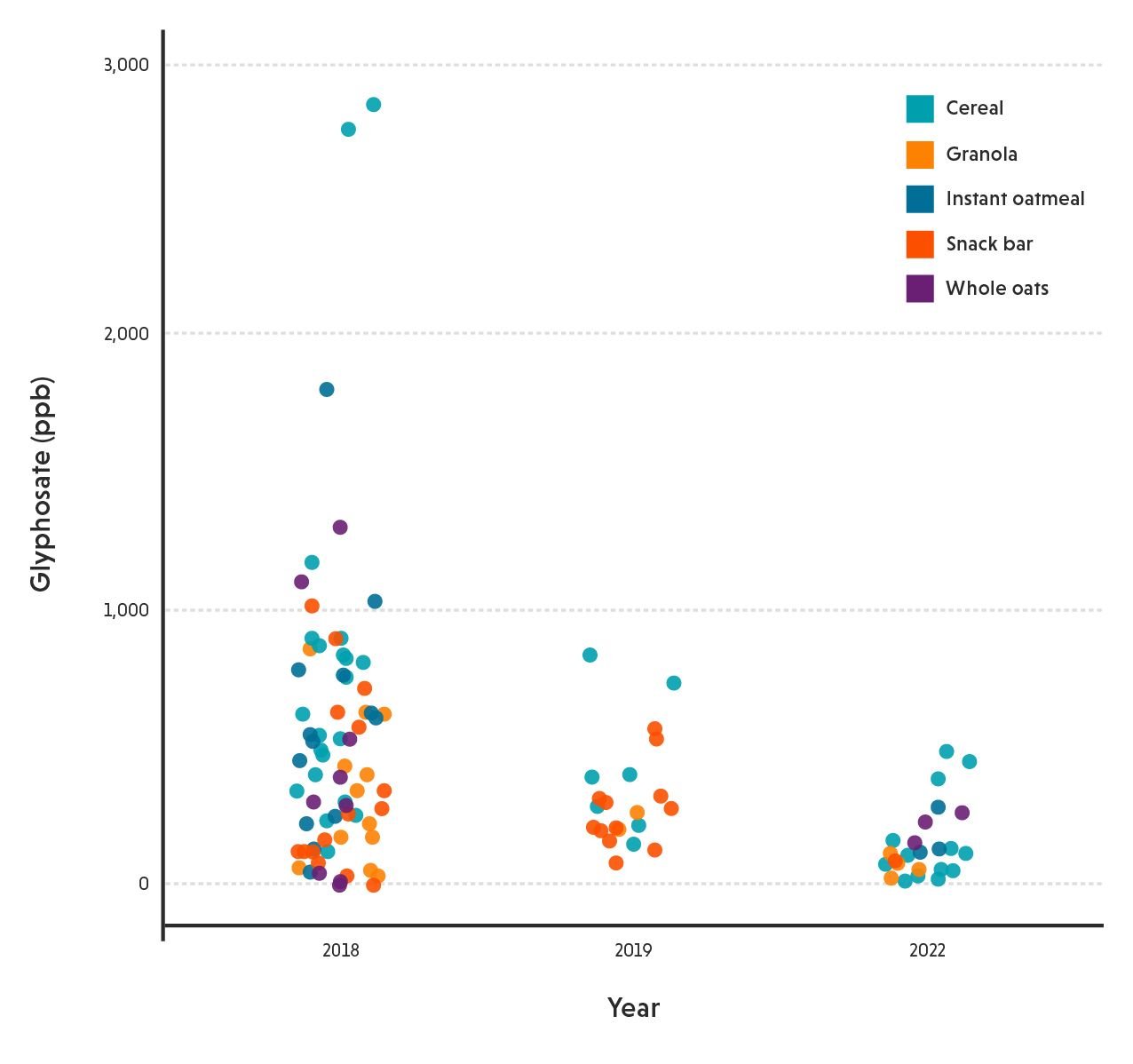
- Levels of the harmful pesticide glyphosate are on the decline in oat-based products, according to Environmental Working Group tests.
- EWG’s advocacy calling for an end to the pre-harvest use of glyphosate on oats may have helped drive change.
- But glyphosate can still be found at levels of concern – 30 percent of items tested showed high amounts of the pesticide.
When it comes to a harmful pesticide in your cereal or oatmeal, do you want the good or bad news first?
Good news: After years of being detected at alarming levels, the pesticide glyphosate is being found at lower levels, on average, in cereal and other oat-based products that children and adults enjoy. Glyphosate has been linked to severe health problems.
Bad news: This toxic chemical is still showing up in popular brands of cereals and other oat-based products.
Those are the findings of EWG’s latest tests of oat-based food products for glyphosate, sold commercially under the name Roundup. For years the chemical has been linked to cancer. Newer human studies also suggest glyphosate exposure during pregnancy may be associated with lower birth weight and shorter pregnancy. And a peer-reviewed study published in March found children exposed to glyphosate are at greater risk of metabolic and liver diseases.
Glyphosate is widely used on crops just before harvest to dry them out. It doesn’t belong in food children and adults eat every day, like cereal, oatmeal and oat-based snack bars.
EWG has long led calls to get it out of our food, and our latest test results signal the campaign is producing results.
How we tested products
For this recent project, we tested several popular brands of oat-based products, including General Mills and Quaker, to find out how much glyphosate they contain.
In total, we tested 24 samples of 14 non-organic oat-based products. Glyphosate was detected on all non-organic, or conventional, samples. The average amounts of glyphosate detected were in some cases much lower than in our 2018 and 2019 rounds of tests.
Even the most contaminated products we tested were a testament to huge progress in companies’ cutting the amount of glyphosate they contain. In 2018, two Quaker Oatmeal Squares samples had detectable levels of almost 3,000 parts per billion, or ppb. In the latest round of sampling, that plummeted to less than 500 ppb – and as low as 20 ppb.
In 2018, two Quaker Oatmeal Squares samples had detectable levels of almost 3,000 parts per billion, or ppb. In the latest round of sampling, we tested four samples of three different flavored Quaker Oatmeal Squares, with results showing glyphosate at less than 500 ppb – and as low as 20 ppb.
Glyphosate levels are dropping – but it’s still being found
Glyphosate levels in some oat-based products like cereals, granola, instant oatmeal, snack bars and whole oats are dropping. (See Figure 1.) But it’s not all promising news. We’re still finding glyphosate in several products.
Figure 1. Tests show glyphosate in oat-based products dropping from 2018 to 2022

Previous EWG tests found a high frequency of concentrations above EWG’s health benchmark, or the amount we believe can reasonably be considered safe to consume, based on the latest science. Our latest round of tests showed concentrations of glyphosate above our health benchmark in just under a third of conventional samples.
EWG’s benchmark for glyphosate is 160 ppb, much lower than both the Environmental Protection Agency’s dietary exposure limit and California’s No Significant Risk Level.
The highest concentrations showed up in Quaker products, as they did in earlier tests. The three highest concentrations were found in flavors of Quaker Oatmeal Squares. Seven samples tested for both glyphosate and chlormequat contained detectable levels of both. This suggests these chemicals are present together in many oat-based foods. Chlormequat is an agricultural chemical that can harm development and the reproductive system in animals.
Cancer-causing chemicals shouldn’t be in our food.
More good news for oat-based baby products
In 2022, EWG also conducted our first tests of baby cereals, and they were largely free of glyphosate. The few low detections we found may be due to cross-contamination during production.
The conventional samples with the two highest detectable levels of glyphosate were both Beech-Nut Oatmeal Whole Grain Baby Cereal. No glyphosate was found in nine conventional Gerber oatmeal products.
Only one sample of oat-based infant cereals, Beech-Nut Oatmeal Whole Grain Baby Cereal, had a low concentration of chlormequat.
EWG also tested three samples – Gerber’s Baby Cereal, Quaker Old Fashioned Oats and General Mills Cheerios – for 414 pesticides and three herbicides – dicamba, paraquat and 2,4-D. None of these chemicals was found above the test lab’s limit of detection.
Our findings resemble those from the Department of Agriculture, which detected very few pesticides when it analyzed 695 oat samples for 473 pesticides, in 2019.
What’s driving the change?
We don’t know why we found less glyphosate in our most recent tests. It could be a result of pandemic-related supply chain issues or price increases.
But we think our advocacy work on the issue could be an important factor. Because of media and public attention on EWG’s first few rounds of oat tests, several companies, including Kellogg’s, pledged to source their oats from growers who don’t use glyphosate as a pre-harvest drying agent, or desiccant.
A Canadian initiative called Keep It Clean even advises grain producers that “some grain buyers may not accept cereal crops treated with pre-harvest glyphosate.”
Still, monitoring this chemical in commonly consumed foods should be the federal government’s responsibility, not ours. In 2018, the Food and Drug Administration released glyphosate testing for corn and soybeans, yet didn’t test oats and other grains, which our data shows are heavily contaminated with glyphosate. And the USDA’s Pesticide Data Program collected nearly 700 samples of oats in 2019, but didn’t test them for glyphosate.
It’s not just a lack of adequate federal testing that results in pesticides ending up on our food. The conventional agriculture industry, and even the EPA, often claim pesticides are safe right up until the moment they are banned because of overwhelming evidence showing they are toxic to humans. Chlorpyrifos is a great example of this.
That’s why EWG will continue to call for strict pesticide regulation and for getting potentially harmful pesticides out of food sold in the U.S. As our latest tests show, with glyphosate, advocacy is a powerful tool that can help bring about positive change.
Want to know if glyphosate is in your favorite food?
The following detailed results of our tests for glyphosate cover both organic and conventional product samples from popular brands of baby food, whole oats, oatmeal, cereal and snack bars.



